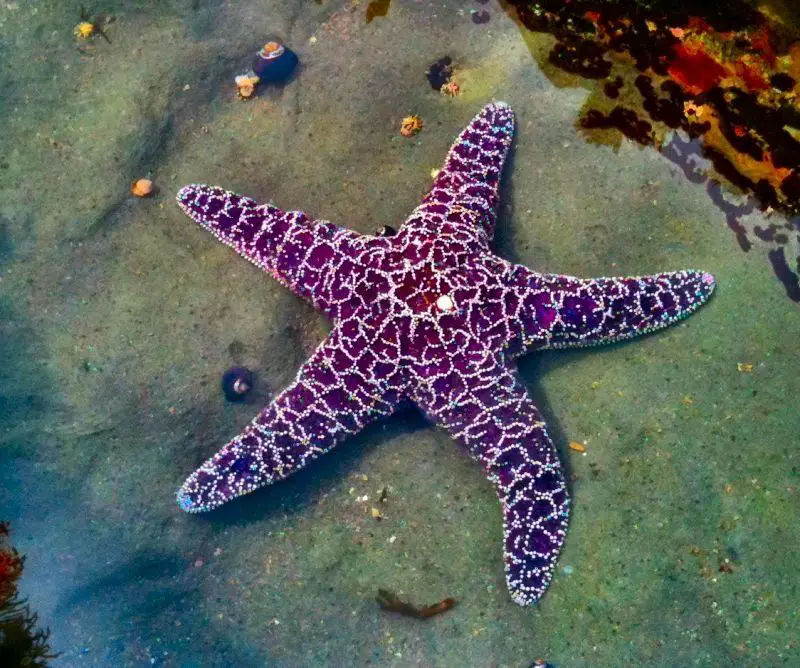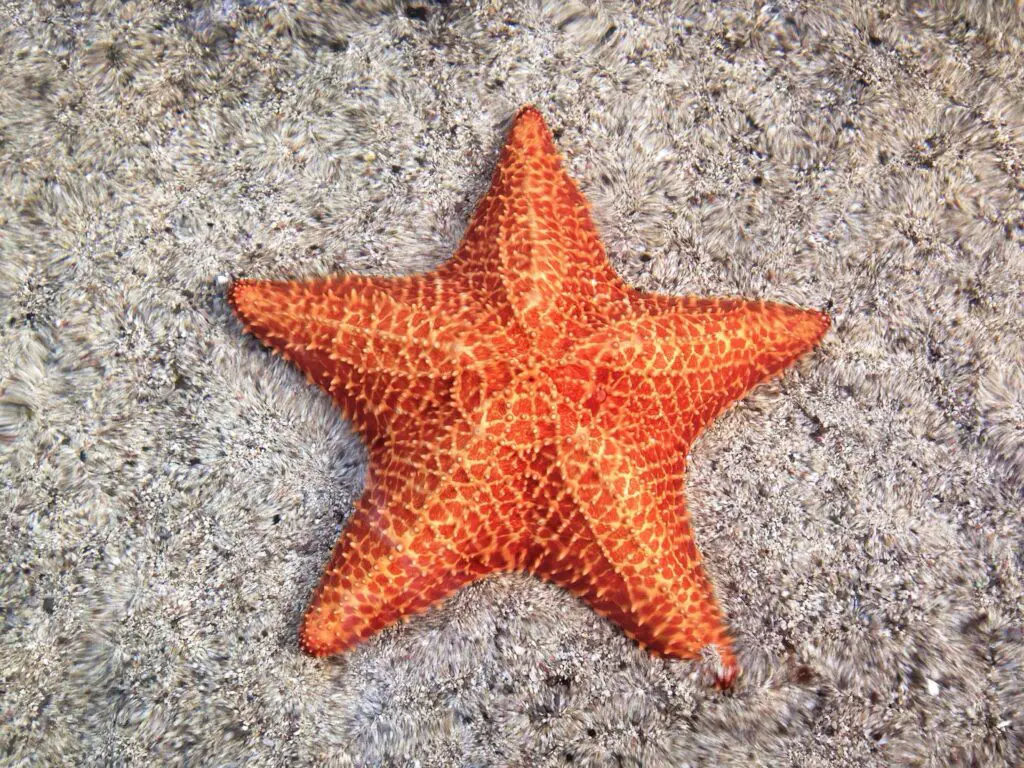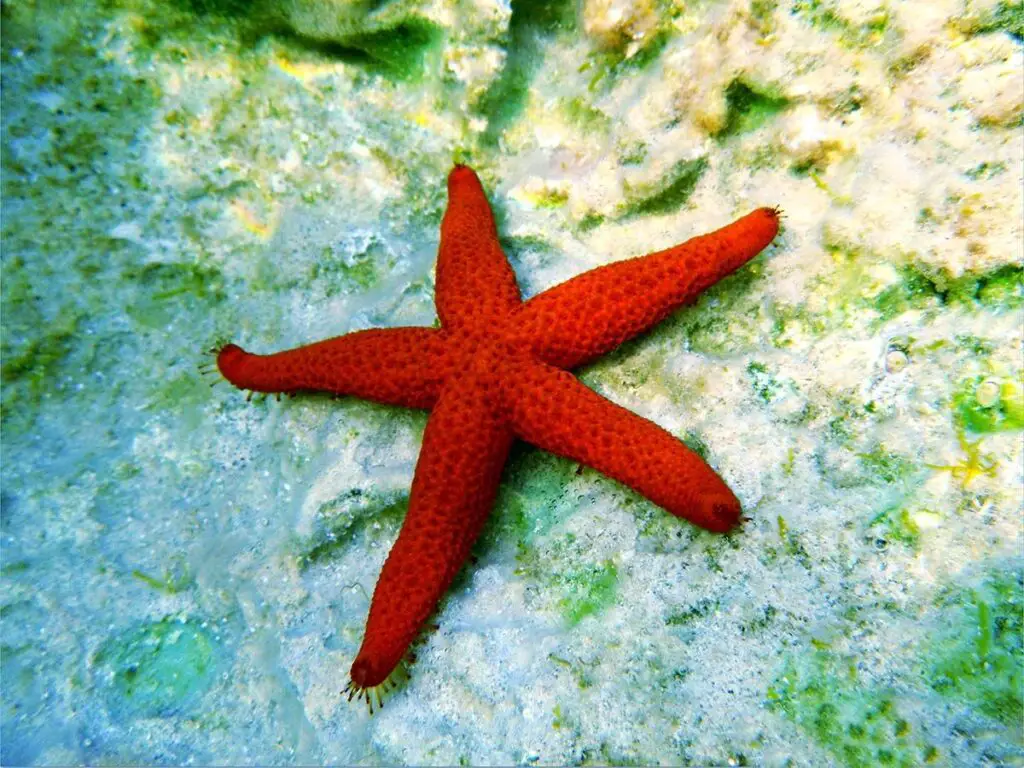Do Starfish Have Brains

Introduction
Do Starfish Have Brains: Beneath the serene depths of our planet’s oceans, where sunlight barely penetrates and the world is cloaked in an otherworldly silence, lies a realm of wonders and mysteries that continue to captivate our imagination. Among the inhabitants of this liquid realm are the starfish, or sea stars, with their mesmerizing radial symmetry and seemingly simple anatomy. Yet, one question has intrigued marine biologists and curious minds alike: “Do Starfish Have Brains?”
In our exploration of the enigmatic world of starfish, we embark on a journey to unravel the complexities of their biology and cognition. At first glance, starfish appear as graceful, slow-moving creatures, relying on their unique water vascular system and tube feet for locomotion and feeding. But beneath this seemingly uncomplicated exterior lies a fascinating array of adaptations and behaviors that challenge our understanding of intelligence in the animal kingdom.
In this quest for knowledge, we delve into the physiology of starfish, seeking clues to whether they possess a centralized nervous system akin to a brain. We examine their behaviors, from their remarkable ability to navigate their watery world to their sophisticated strategies for predation and survival. We also explore the mechanisms behind their regenerative capabilities, which are nothing short of astonishing.
Join us as we venture into the world of starfish reproduce cognition, where answers to questions about brains and intelligence may surprise and inspire. The story of starfish, creatures that thrive in one of Earth’s most extreme environments, is a testament to the marvels of adaptation and evolution. As we dive deeper into the mysteries of starfish, we come to appreciate the intricate web of life that thrives beneath the waves and the myriad ways in which creatures like starfish have carved their niche in the ocean’s timeless dance.

Can a starfish think?
The starfish do not have a brain, but they are not fools. They have a complex nervous system that allows them to make a decision. This nervous system is centralized in the ring around the mouth.
Starfish, also known as sea stars, do not possess a centralized brain as humans and some other animals do. Instead, they have a decentralized nervous system consisting of a nerve ring and radial nerves that run along their arms. This nervous system allows them to perform essential functions such as sensing their environment, responding to stimuli, and coordinating their movements. However, this system does not support complex cognitive processes or thinking as we understand it.
Starfish primarily rely on instinctual behaviors and basic reflexes to navigate their surroundings and interact with their environment. Their decentralized nervous system helps them carry out essential functions like feeding, responding to threats, and finding suitable habitats, but it does not enable them to process information in the way that a centralized brain does.
In summary, starfish exhibit behaviors and responses that are essential for their survival, but they do not possess the capacity for conscious thought or complex cognitive processes.
Do starfish have intelligence?
SNAILS, jellyfish and starfish have taught us that you don’t need a brain to learn. These seemingly simple creatures are capable learners, despite being completely brainless. Perhaps this is no great surprise.
Starfish, while lacking a centralized brain and the kind of intelligence associated with more complex animals, have evolved a set of behaviors and adaptations that reflect their capacity to interact with their environment effectively. Their intelligence is best described as a form of “animal intelligence” or “instinctual intelligence” rather than the kind of advanced cognitive abilities seen in animals with more complex nervous systems.
Starfish exhibit several intelligent behaviors:
Navigation: They can navigate their surroundings, responding to changes in light, temperature, and chemical cues. This allows them to locate suitable habitats and find food.
Feeding: Starfish are efficient predators that use their tube feet to capture and manipulate prey. Their ability to sense and respond to the presence of potential prey demonstrates a level of intelligence in terms of foraging and hunting.
Defense: Starfish have various mechanisms for defending themselves against predators. Some can regenerate lost limbs as a defense strategy, and others have specialized structures like spines or toxins to deter attackers.
Regeneration: The ability of starfish to regrow lost limbs is a remarkable adaptive feature and reflects a form of regenerative intelligence.
While starfish do not possess the cognitive capacities of animals with more complex brains, they have evolved behaviors and adaptations that are highly effective for their ecological niche in the marine environment. Their intelligence is a testament to the diversity of life on Earth and the unique ways in which organisms adapt to their surroundings.
Is it OK to touch starfish?
“Simply put, starfish absorb oxygen from water through channels on their outer body. You should never touch or remove a starfish from the water, as this could lead to them suffocating. “Sunscreen or the oil on our skin can harm sea creatures which is another reason not to touch them.”
Touching starfish can be acceptable under certain conditions, but it’s essential to do so with care and consideration for their well-being and their environment. When encountering starfish in their natural habitat, such as tide pools or while snorkeling or diving, here are some guidelines to keep in mind:
Be Gentle: If you choose to touch a starfish, do so gently and with clean hands. Avoid excessive pressure or handling that could injure them.
Wet Hands: Ensure your hands are wet when touching starfish. Wet skin is less likely to damage their delicate skin or interfere with their ability to breathe.
Avoid Excessive Handling: Minimize the duration of contact, and refrain from moving starfish out of the water. Starfish rely on seawater to support their body structures and functions, so removing them from their natural environment can be harmful.
Watch for Local Regulations: In some protected areas, touching or disturbing marine life, including starfish, may be prohibited. Always follow local guidelines and regulations.
Respect Their Space: Allow starfish to go about their activities undisturbed. Avoid crowding or interfering with their natural behaviors.
Remember that starfish play vital roles in marine ecosystems, and disturbing them unnecessarily can disrupt their activities and impact their survival. It’s important to approach wildlife encounters with respect for the animals and their environment.
Can starfish see us?
Starfish have eyes
Whilst their eyes may not be able to see in fine detail like our eyes can, they are able to detect different shades of light allowing them to navigate their surroundings – allowing them to hunt for food and hide from predators.
Starfish have relatively simple eyespots, also known as ocelli, located at the tips of their arms. These eyespots are primarily sensitive to changes in light and dark and help starfish detect variations in lighting conditions in their underwater environment. However, their visual abilities are quite limited compared to animals with more advanced visual systems.
Starfish cannot form detailed images or recognize specific objects like humans can. Their eyespots are better suited for detecting shadows, movements, and changes in light levels. They are more attuned to sensing their environment than specifically “seeing” in the way humans do.
So, while starfish have a rudimentary form of vision that allows them to respond to changes in lighting conditions, they do not possess the visual acuity or complexity to perceive individual humans or objects in detail. Their visual abilities are adapted to the challenges of life in the marine environment and serve basic sensory functions.
Do starfish bite humans?
Most starfish are not poisonous, and since they can’t bite or sting us, they pose no threat to humans. However, there’s a species called the crown-of-thorns starfish which is venomous, and if their spines pierce the skin they can be venomous.
No, starfish do not have the physical capability to bite humans or any other creatures. Starfish have a very different anatomy and feeding mechanism compared to animals with jaws or teeth. They are marine invertebrates with a water vascular system and tube feet that they use for locomotion and capturing prey.
Starfish are primarily scavengers or predators of slow-moving or sessile (non-moving) marine animals like mollusks and small crustaceans. Their feeding process involves using their tube feet to grasp and immobilize their prey, then pushing their stomach out of their body to digest the prey externally. This process allows them to feed on the soft tissues of their prey, but it is not a “bite” in the conventional sense.
While starfish are not equipped to bite humans, it’s important to handle them with care and respect if encountered in their natural habitat. Touching or picking up a starfish should be done gently to avoid causing harm to the animal or disrupting its activities.
Is it cruel to hold a starfish?
The answer is simple: starfish die when they are taken out of the water. Since starfish cannot stay in the water and breathe, they suffer from carbon monoxide poisoning, which causes them to die from asphyxiation. Another common cause of death is stress from handling them too much.
Holding a starfish can be done without cruelty if it is done with care and consideration for the animal’s well-being and its natural habitat. Here are some guidelines to keep in mind when handling starfish:
Be Gentle: When picking up or holding a starfish, do so gently and with clean, wet hands. Avoid squeezing or applying excessive pressure that could damage the animal’s delicate skin or tube feet.
Keep Them in Water: If you remove a starfish from the water, it’s essential to keep it moist and ensure that it has access to seawater. Starfish rely on seawater to support their body structures and functions, and prolonged exposure to air can be harmful.
Minimize Handling: Minimize the duration of contact and avoid unnecessary handling. Returning the starfish to its natural habitat as quickly as possible is ideal.
Respect Their Space: Allow starfish to go about their activities undisturbed. Avoid crowding or interfering with their natural behaviors.
Follow Local Regulations: In some protected areas or marine reserves, handling or disturbing marine life, including starfish, may be prohibited. Always follow local guidelines and regulations.
In summary, it is not inherently cruel to hold a starfish as long as it is done with care and respect for the animal and its environment. Responsible handling practices can help ensure that the starfish is not harmed and can continue its activities in its natural habitat.
Are starfish blind?
While sea stars don’t exactly see like we do, they definitely aren’t blind. Instead of eyeballs, sea stars have tiny eye ‘spots’ embedded beneath the skin of each arm.
Starfish are not blind in the traditional sense, but their vision is rudimentary and differs significantly from human vision. Starfish have simple eyespots, also known as ocelli, located at the tips of their arms. These eyespots are sensitive to changes in light and dark and help starfish detect variations in lighting conditions in their underwater environment.
However, starfish’s visual abilities are limited compared to animals with more advanced visual systems. They cannot form detailed images, recognize specific objects, or perceive fine details. Instead, their eyespots are primarily attuned to sensing the presence of shadows, movements, and changes in light levels in their surroundings.
Starfish rely on other sensory adaptations, such as their sense of touch and chemoreception (the ability to detect chemicals in the water), to navigate their environment, locate prey, and respond to stimuli. These sensory mechanisms are better suited for their underwater existence and the challenges of life in the marine environment.
In summary, starfish are not blind, but their vision is very basic and serves a primarily sensory role rather than providing them with detailed visual information about their surroundings.
Can starfish see in Colour?
There are indications that they are involved in negative phototaxis but this may also be governed by extraocular photoreceptors. Here, we show that the eyes of the coral-reef-associated starfish Linckia laevigata are slow and colour blind.
Starfish do not have the capability to see in color as humans do. Their visual system, consisting of simple eyespots or ocelli located at the tips of their arms, is primarily sensitive to changes in light and dark. These eyespots help them detect variations in lighting conditions in their underwater environment.
Color vision, as humans experience it, requires specialized photoreceptor cells called cones that can detect different wavelengths of light and convey information about colors. Starfish lack these specialized structures in their visual system, which limits their ability to perceive colors.
Instead, starfish rely on their rudimentary eyespots to detect shadows, movements, and changes in light levels, which can help them navigate their surroundings and respond to basic visual cues. Their visual capabilities are adapted to the underwater environment and the challenges of life in the marine world, where color vision is not as essential as it is for animals in terrestrial habitats.

Conclusion
In the depths of the ocean, where the boundaries of our understanding meet the wonders of nature, the enigmatic starfish, or sea star, has proven to be a subject of both fascination and scientific inquiry. As we conclude our exploration into the question, “Do Starfish Have Brains?” we find ourselves standing on the shores of newfound knowledge, humbled by the mysteries that still linger beneath the waves.
Starfish, with their characteristic radial symmetry and seemingly simple anatomy, have challenged our preconceptions about intelligence and cognition in the animal kingdom. While they do not possess a centralized brain in the way mammals or some other animals do, they exhibit a level of complexity and adaptability that is nothing short of remarkable.
Their decentralized nervous system, comprised of a nerve ring and radial nerves, enables them to sense and respond to their environment. This unique neural architecture allows starfish to navigate their underwater realm, locate prey, and carry out a host of other behaviors essential for their survival.
Yet, perhaps the most astonishing aspect of starfish biology is their regenerative abilities. They can regrow lost limbs and even regenerate into complete individuals from severed parts. This remarkable capability reflects a level of sophistication in cellular communication and tissue regeneration that continues to captivate scientists.
As we reflect on the journey into the world of starfish cognition, we are reminded that intelligence takes on diverse forms in the natural world. Starfish have adapted to their environment in ways that challenge conventional notions of what it means to possess a brain. They are a testament to the boundless ingenuity of life and the ceaseless wonders that await discovery beneath the ocean’s surface.
In our ongoing exploration of the mysteries of the deep, the starfish serves as a reminder that every corner of our planet holds the potential for new revelations and a deeper appreciation of the intricate web of life that connects us all. The question of whether starfish have brains may remain complex, but their place in the tapestry of life is unquestionably awe-inspiring.



